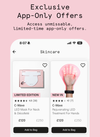From E.L.F. Cosmetics’ surge in app engagement to Sephora’s loyalty innovations, the beauty sector is proving that app-first strategies drive real results.
In the increasingly competitive world of beauty eCommerce, one trend is gaining undeniable momentum: brands are doubling down on mobile apps. From loyalty programs to personalised content and first-party data capture, apps are becoming a core pillar of growth strategy - and the brands moving early are already seeing tangible returns.
Take E.L.F Cosmetics, for example. In early 2024, the brand reported a 125% increase in monthly active app users, driven by a blend of exclusive content, loyalty integration, and a more seamless mobile shopping experience. This wasn’t just a UX play, it was a data-driven decision, reflecting the broader reality that mobile app users tend to be more engaged and higher value than mobile web visitors.
In fact, according to AppsFlyer data, 56% of installs for beauty apps in 2025 were non-organic - meaning they came from an attributed marketing touchpoint like an ad, owned media, or influencer campaign. These are not passive users; they’re acquired intentionally, and they’re converting. On average, 27% of users who install a beauty app in the UK make an in-app purchase within the first 30 days.
That’s a significant metric for marketers who are under pressure to drive ROI and increase customer LTV.
But it’s not just about install volume, it’s about strategy.
Beauty app strategies that stand out:

- Charlotte Tilbury launched their app in 2023 and focused on personalisation, augmented reality, and immersive storytelling to convince app downloads, with a live calendar of makeup tutorial events in-app to drive stickiness and retention.
- Beauty Pie launched its app in March this year with a clear value exchange: an improved member experience for subscribers, with exclusive access to content and products.
- Sephora continues to use its app as a central hub for its loyalty program, providing deeper engagement, personalisation, and push-enabled retention opportunities.
While the front-end experiences differ, one thing unites these brands: a thoughtful approach to app store optimization (ASO) and Apple Ads - ensuring the app is discoverable, enticing, and positioned to convert.
Owned media is an underutilised superpower!
Many beauty brands are sitting on under-leveraged channels when it comes to app growth. Recent AppsFlyer data shows that web-to-app smart banners - particularly those placed at the bottom of the mobile site - are the most effective owned media journeys for driving installs. These placements significantly outperform static top banners in both click-through and conversion rates.
Similarly, QR codes on product packaging or in-store displays offer a low-friction, brand-owned path to drive app usage - a tactic that’s especially effective in the beauty category, where physical and digital experiences increasingly intersect.

The future is app-first!

Apps are no longer just a retention tool - they’re becoming a primary vehicle for growth, loyalty, and data collection. For beauty brands still sitting on the fence, the message is clear: the opportunity cost of not having a dedicated app is rising.
Sephora has utilised tools like Apple’s app events, enabling them to surface rich, time-sensitive content in the App Store itself - whether that’s a seasonal sale, product drop, or exclusive in-app event. When paired with strong attribution, ASO and Apple Ads strategy, and owned media activation, beauty apps can become a scalable engine for both acquisition and loyalty.
The bottom line?
The best beauty brands aren’t just selling products - they’re building ecosystems. And increasingly, those ecosystems are powered by apps. Are you building one?
Blog Credits: Sue Azari, Appsflyer
(data source: Appsflyer, 2025)